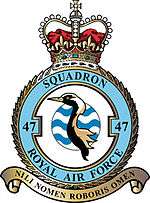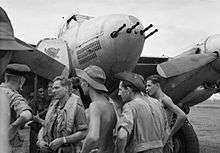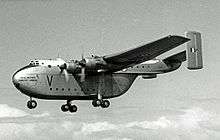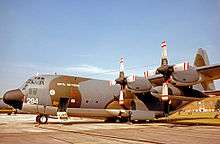No. 47 Squadron RAF
| No. 47 Squadron RAF | |
|---|---|
 | |
| Active |
1 March 1916–October 1919 1 February 1920–21 March 1946 1 September 1946–31 October 1967 25 February 1968–present |
| Country |
|
| Branch |
|
| Role | Air Transport |
| Garrison/HQ | RAF Brize Norton |
| Motto(s) |
Latin: Nili nomen roboris omen ("The name of the Nile is an omen of our strength") |
| Equipment | Lockheed C-130 Hercules |
| Battle honours |
Macedonia 1916–1918*, East Africa 1940–1941*, Egypt and Libya 1942*, Mediterranean 1942–1943*, Burma 1945*, South Atlantic 1982, Gulf 1991, Iraq 2003* *Denotes honours emblazoned on standard[1] |
| Insignia | |
| Squadron badge heraldry |
In front of a fountain, a demoiselle crane's head erased. approved by King George VI in November 1938. The unofficial badge had been a sun rising over a pyramid, but tours in Russia and Sudan inspired the use of a crane (found in both countries) which, when navigating, flies high like a bomber. The fountain commemorates the amphibious role when seaplanes were flown off the Nile. |
| Squadron Codes |
EW Allocated Apr 1939–Sep 1939 KU Sep 1939–Sep 1942, Feb 1945–Mar 1946 |
No. 47 Squadron of the Royal Air Force operates the Lockheed C-130 Hercules from RAF Brize Norton, Oxfordshire, England.
History
First formation
No. 47 Squadron Royal Flying Corps was formed at Beverley, East Riding of Yorkshire on 1 March 1916 as a home defence unit, protecting Hull and East Yorkshire against attack by German Zeppelins, being equipped with a mix of aircraft, including Armstrong Whitworth F.K.3s, FK.8s and Royal Aircraft Factory BE.12s.[2][3] After six months training and flying defensive patrols, it was split up, with two flights joining 33 Squadron, and the remainder being sent to Salonika in Greece, to support forces fighting on the Macedonian Front, arriving on 20 September 1916.[4]

It retained a mixture of aircraft, with two flights being used for reconnaissance and bombing while the third flight operated fighters. When the German battlecruiser Goeben ran aground near outside the Dardanelles after the Battle of Imbros, three 47 Squadron aircraft were sent to attack the stranded ship. Despite continual attacks from these and other aircraft little damage was done to the Goeben owing to the light bombs used. On 1 April 1918, the Royal Flying Corps became part of the Royal Air Force, and the fighter flights (by now equipped with the Royal Aircraft Factory S.E.5A) of both 47 Squadron and No. 17 Squadron were detached to form 150 Squadron. 47 Squadron, now divested of its fighters, and solely equipped with Armstrong Whitworth F.K.8s, was used mainly in the Corps Reconnaissance role, but were used to bomb the retreating Bulgarian forces following the Allied offensive of September 1918.[4][5][6]
After the end of World War I, in April 1919, the squadron was sent to Southern Russia to help General Denikin's White Russian forces in their fight against the Bolsheviks in the Russian Civil War. While the RAF's ostensible mission was purely to provide training to Denikin's forces, No. 47 Squadron was included in the mission in order to carry out operational sorties.[7] It was equipped with a mixture of aircraft, with flights equipped with Airco DH.9 and DH.9A bombers and Sopwith Camel fighters. The squadron's flights operated independently, carrying out bombing and strafing missions against Bolshevik forces.[4] One notable incident occurred on 30 July 1919, when, during an attack by C Flight DH.9s on Bolshevik gunboats at Tcherni-Yar, the DH.9 flown by William Elliot was shot down. On seeing this, the DH.9 flown by Captain Anderson, despite itself receiving damage that required his gunner, Lt Mitchell to climb onto the wing and block a leaking fuel tank with his thumb, landed next to the stricken aircraft to rescue its crew.[8][9] Anderson and Mitchell were recommended for the Victoria Cross for this action, but in the end they were awarded the Distinguished Service Order.[10] No. 47 Squadron was disbanded on 7 October 1919, being re-designated 'A' Squadron, Royal Air Force Instructional Mission, South Russia.[5]
Although it was not a fighter unit, the squadron did have at least two aces serve in it: Samuel Kinkead[11] and Charles D. B. Green.[12]
1920–1944 East Africa and the Mediterranean
On 1 February 1920 the squadron was re-formed at RAF Helwan in Egypt when 206 Squadron was re-numbered. It was a day bomber squadron equipped with the DH.9, re-equipping with Airco DH.9As in 1921.[13] One of the duties was policing in Sudan and the squadron detached aircraft to Khartoum.[6] Another important task carried out during the Squadron's early years in Egypt was to help survey and mark out the route of the Cairo to Baghdad air route, and to carry air mail along that route.[14] Between 27 October and 19 November 1925, three aircraft, led by Squadron Leader Arthur Coningham (later an Air Vice Marshal and commander of the Western Desert Air Force during the Second World War), carried out the first RAF round trip flight between Egypt and Kano, Nigeria, covering 6,500 miles in 24 days, with 85 hours flying time.[14][15]
In October 1927 the squadron moved completely to Khartoum[13] and in December it discarded its aging DH.9As in favour of Fairey IIIFs, becoming the first Squadron to receive this aircraft.[16] The squadron co-operated with the Sudan Defence Force, regularly carrying out border patrols,[6] while a flight of IIIFs was fitted with floats, flying patrols over the River Nile and the Red Sea.[13] It also continued to carry out long range flights, flying from Egypt to The Gambia in 1930, and carrying out four training flights to South Africa.[14] The Squadron replaced its IIIFs with Fairey Gordons (effectively IIIFs powered by a radial engine) in January 1933,[17] continuing its operations in support of the Sudan Defence Force and floatplane patrols over the Red Sea.[13]
In July 1936 the squadron re-equipped with the Vickers Vincent, although some float-equipped Gordons were kept until June 1939.[13][18] In June 1939 the squadron started to operate the Vickers Wellesley monoplane, retaining a flight of Vincents for Army co-operation purposes.[5] To counter Italian forces entering the war the squadron moved north to Erkowit and flew its first combat mission of the Second World War against Asmara airfield in Eritrea on 11 June 1940.[14] The Vincent equipped D Flight was split off to form No. 430 Flight in August 1940, that flight continuing in support of Orde Wingate's Gideon Force.[19] while 47 Squadron continued to bomb Italian forces in Eritrea until they surrendered in May 1941, and then flying operations in support of British and Commonwealth forces in Ethiopia until the final Italian surrender in Gondar in November 1941.[14]
The squadron moved to Egypt using the now old Wellesleys in anti-submarine patrols around the eastern Mediterranean, while in July 1942 it acquired a detachment of Bristol Beaufort torpedo bombers from 42 Squadron. It flew its first anti-shipping strikes against enemy convoys supplying the Afrika Korps in Libya on 8 October 1942.[14] It carried on operating Beauforts on anti-shipping as well as convoy escort duties until 1943. In June 1943 the Squadron, by now based in Tunisia, re-equipped with Bristol Beaufighters. Now better equipped at striking against enemy shipping, they carried out armed reconnaissance in different areas of the Mediterranean and Aegean sea looking for shipping to attack.[5][20]
1944–1946 India and the Far East

The squadron moved with the Beaufighters to India in March 1944, re-equipping with de Havilland Mosquitos in October that year. This was not a success as the Mosquito was almost immediately grounded owing to failures of the wooden structure due to the hot and humid Indian climate, and it re-acquired the Beaufighter in November.[5] They were soon supporting operations in Burma in both day and night attacks with rockets. The squadron partly re-equipped with Mosquitos in February 1945, with both its Beaufighters and Mosquitos being heavily used to support General Slim's 14th Army in its attack against Mandalay. It completely re-equipped with Mosquitos in April 1945, continuing operations against Japanese forces until the end of the war. After the war it moved to Java to operate against Indonesian nationalist forces but it was disbanded at Butterworth on 21 March 1946.[21]
1946–1967 Transport

On 1 September 1946 the squadron was re-formed at RAF Qastina in Palestine when 644 Squadron was renumbered. It was now a transport squadron using converted four-engined Handley Page Halifax bombers. It soon returned to the United Kingdom where it flew the Halifax from RAF Fairford in the Army support role.[18] The Squadron moved to RAF Disforth in September 1948, where it became the first RAF Squadron to receive the Handley Page Hastings four-engined transport. The conversion process was rushed as the aircraft were needed to support the Berlin Airlift, with the Squadron moving to Schleswigland, near Kiel in West Germany on 1 November 1948.[22] The aircraft was mainly used to carry coal, carrying out 3,000 trips to Berlin and carrying 22,000 tons of supplies.[23] When the blockade ended the Squadron returned to the United Kingdom, moving to RAF Topcliffe on 22 August 1949, operating in support of airborne forces, moving to RAF Abingdon in May 1953.[24]
In May 1956 the squadron became the first to re-equip with the Blackburn Beverley heavy-lift transport,[13] the large aircraft were used on Transport Command trooping and freight routes. The squadron also supported operations in Cyprus, Kuwait and East Africa and carried out mercy flights related to floods, droughts and natural disasters. The Beverley was withdrawn and the squadron disbanded on 31 October 1967.[18]
1968–2014 Hercules

The squadron was re-formed at RAF Fairford, Gloucestershire, on 25 February 1968 to operate the Lockheed Hercules, moving to Lyneham in September 1971.[13] During the Falklands War, the squadron airlifted supplies to Ascension Island and, later, air dropped men and supplies to ships of the British task force in the South Atlantic. To make the trip from Ascension to the Falklands, several Hercules were given additional fuel tanks and fitted with refuelling probes.[25] 47 Squadron also prepared to fly elements of the Special Air Service(SAS) to Argentina for the aborted Operation Mikado.
The squadron's Special Forces Flight were involved in the 1991 Gulf War, as well as regular airlift missions, the Hercules also flew missions behind Iraqi lines, landing on ad hoc desert air strips to resupply SAS fighting columns.
The squadron has supported UN and NATO operations in the Balkans in the 1990s, delivering aid to several besieged cities. It also support coalition forces in operations in Iraq and Afghanistan.
Following the 2012 closure of RAF Lyneham, Wiltshire, the squadron has been operating from RAF Brize Norton in Oxfordshire.
Squadron affiliations
The squadron has an ongoing affiliation with the Clothworkers Company of the City of London. This affiliation has been in place since 2012 and continues a strong tradition on behalf of the City of London Livery companies of affiliation and support of armed forces fighting units. The Clothworkers Company is also affiliated with HMS Dauntless and the Royal Scots Guards.
A400M Atlas
47 Squadron will be the second Royal Air Force squadron to be equipped with the new Airbus A400M Atlas.[26]
Losses
- June 1999 – during NATO operations in Kosovo, a C.1 Hercules crashed on take off from Kukes airbase in Albania. The Hercules was reportedly carrying a number of troops on an urgent mission to reach Pristina Airport before a column of Russian forces arrived. All aboard survived the crash.
- January 2005 – A Hercules was shot down over Iraq whilst on routine tasking. The low-flying Hercules was hit by enemy ground fire, which caused a fire to break out onboard and led to structural failure and the eventual crash. All crew members and passengers were killed.
- May 2006 – A Hercules was destroyed at Bost Airfield, Lashkar Gah in Helmand Province, Afghanistan. The plane reportedly hit a mine upon landing and burst into flames. The crew and passengers managed to escape the fire but the C-130, 2 armoured 4x4 vehicles and a large quantity of cash was destroyed.
- February 2007 – A Hercules crash-landed at an ad hoc airstrip in Afghanistan whilst supporting UK tasking. The crash was caused by an IED attack. As it was not possible to repair or recover the plane, all sensitive equipment was removed before Royal Engineers blew it up.
References
- Citations
- ↑ "47 Squadron". Royal Air Force. Retrieved 18 July 2010.
- ↑ Yoxall (1955), pp. 454–455.
- ↑ Ashworth (1989), p. 123.
- 1 2 3 Yoxall (1955), p. 455.
- 1 2 3 4 5 Halley (1980), p. 82.
- 1 2 3 Halley (1980), p. 176.
- ↑ Rogers (2005), p. 70.
- ↑ Yoxall (1955), pp. 455–456.
- ↑ Rogers (2005), pp. 69, 70–71.
- ↑ Rogers (2005), p. 73.
- ↑ "Samuel Kinkead". The Aerodrome. Retrieved 19 March 2011.
- ↑ "Charles Green". The Aerodrome. Retrieved 19 March 2011.
- 1 2 3 4 5 6 7 Ashworth (1989), p. 124.
- 1 2 3 4 5 6 Yoxall (1955), p. 456.
- ↑ "Cairo-Kano-Cairo Flight Concluded". Flight. XVII (883): 784. 26 November 1925.
- ↑ Thetford (May 1994), pp. 33–34.
- ↑ Thetford (June 1994), pp. 17–18.
- 1 2 3 Halley (1980), p. 83.
- ↑ Thetford (1995), p. 22.
- ↑ Yoxall (1955), pp. 456–457.
- ↑ Yoxall (1955), pp. 457, 468.
- ↑ Jackson (1989), p. 4.
- ↑ Yoxall (1955), p. 468.
- ↑ Jackson (1989), p. 5.
- ↑ Burden et al (1986), pp. 405–409.
- ↑ Air Forces Monthly. Stamford, Lincolnshire, England: Key Publishing Ltd. April 2013. p. 8.
- Bibliography
- Ashworth, Chris (1989). Encyclopaedia of Modern Royal Air Force Squadrons. Wellingborough, UK: Patrick Stephens Ltd. ISBN 1-85260-013-6.
- Burden, Rodney A.; Draper, Michael I.; Rough, Douglas A.; Smith, Colin R. & Wilton, David (1986). Falklands: The Air War. Twickenham, UK: British Aviation Research Group. ISBN 0-906339-05-7.
- Chorlton, Martyn (November 2014). "Battle Honours – 47 Squadron: Harassing the Italians out of East Africa". Aeroplane. 42 (11): 42–46.
- Halley, James J. (1980). The Squadrons of the Royal Air Force. Tonbridge, Kent, UK: Air Britain (Historians). ISBN 0-85130-083-9..
- Jackson, Paul (September–December 1989). "The Hastings...Last of a Transport Line". Air Enthusiast (40): 1–7, 47–52.
- Lewis, Peter (1959). Squadron Histories: R.F.C, R.N.A.S and R.A.F. 1912–59. London: Putnam.
- Rogers, M. W. (May–June 2005). "Walter F. Anderson Canadian Hero: The RAF in South Russia 1919–1920". Air Enthusiast (117): 69–75.
- Thetford, Owen (May 1994). "By Day and By Night: Fairey IIIF and Gordon in Service". Aeroplane. 22 (5): 32–38.
- Thetford, Owen (June 1994). "By Day and By Night: Fairey IIIF and Gordon in Service". Aeroplane. 22 (6): 16–20.
- Thetford, Owen (March 1995). "By Day and By Night: Vincents in Service". Aeroplane. 23 (3): 18–22.
- Yoxall, John (8 April 1955). "No. 47 Squadron: History of a Famous Transport Command Unit". Flight. 67 (2411): 454–457, 468.
External links
| Wikimedia Commons has media related to No. 47 Squadron RAF. |
- "47 Squadron". Royal Air Force.
